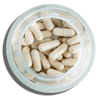Telomerase is an enzyme that maintains chromosome integrity by extending telomeres, the protective caps at the ends of chromosomes. While it slows aging in some cells, its unchecked activity is linked to cancer, as 85–90% of malignant tumors rely on telomerase for "immortality." However, about 10–15% of cancers use alternative methods to maintain telomeres. Research shows a U-shaped cancer risk curve: both very short and very long telomeres can increase cancer risks.
Key points:
- Aging and Telomerase: Telomerase slows telomere shortening, delaying aging in stem cells, but is largely inactive in most body cells.
- Cancer Risks: High telomerase activity is linked to tumor growth, while short telomeres can also contribute to DNA damage and cancer.
- Therapies: Telomerase inhibitors like Imetelstat target cancer cells, while activators like TA-65 show promise for longevity without increasing cancer risks in short-term studies.
- Genetic Mutations: TERT promoter mutations are common in certain cancers, such as melanoma and glioblastoma.
- Challenges: Balancing telomerase activation for aging and inhibition for cancer remains a key focus of research.
Future therapies aim to harness telomerase safely for aging and cancer treatments, while supplements like NMN, Resveratrol, Fisetin, and Spermidine offer indirect ways to support cellular health today.
How telomere length impacts cancer risk
Key Research Findings on Telomerase and Cancer Risks
Understanding these findings is critical for navigating the delicate balance between telomerase activation in longevity treatments and the associated cancer risks.
Population Studies on Telomerase Activity
Population studies paint a complicated and sometimes conflicting picture of the relationship between telomerase activity and cancer risk. A large meta-analysis examining 23,379 cancer cases and 68,792 controls found no overall link between short telomeres and cancer risk[2]. However, when broken down by cancer type, the story changes. Short telomeres were associated with a 62% higher risk of gastrointestinal tumors (OR = 1.62, 95% CI: 1.33–1.97) and an 86% increased risk of head and neck cancers (OR = 1.86, 95% CI: 1.23–2.82)[2].
Lung cancer research adds another layer of complexity. One study reported significantly lower telomerase activity in lung cancer patients compared to healthy individuals (1.31 ± 1.65 vs. 2.60 ± 3.09; P < 1×10⁻⁴), with low telomerase activity linked to a tripling of lung cancer risk (adjusted OR, 3.05; 95% CI, 1.60–5.82)[3]. On the flip side, prospective studies have found that short telomeres are tied to a 22% reduced risk of lung cancer (OR = 0.78, 95% CI: 0.67–0.91)[2]. These contrasting findings suggest that the relationship between telomerase activity and cancer development is far from straightforward and may vary by cancer type and individual factors.
These population trends provide a foundation for exploring genetic alterations in telomerase.
Telomerase Mutations and Cancer Development
Genetic research shows that mutations in the TERT promoter - a hotspot for non-coding cancer mutations - play a significant role in cancer development[1]. These mutations, primarily C>T transitions occurring at –124 and –146 base pairs from the transcription start site, are frequently observed in various cancers[4]. For instance, TERT promoter mutations are found in:
- 64–80% of melanoma cases
- Approximately 84% of glioblastoma cases
- Around 65% of bladder cancer cases
- 32–45% of hepatocellular carcinomas[4]
In contrast, cancers with high proliferation rates, such as breast cancer and testicular cancer, show much lower mutation rates (0.9% and 3%, respectively)[4].
Specific studies add further depth. A 2021 investigation by Yu et al. on oral cavity squamous cell carcinoma revealed an 81% TERT mutation rate, with these mutations linked to an increased risk of treatment failure (subdistribution HR, 2.82; 95% CI, 1.47–5.42; P = 0.0019)[6].
Meta-Analysis Results on Telomere Length and Cancer
Meta-analyses reveal a U-shaped risk curve: both extremely short and unusually long telomeres are associated with higher cancer risks. Dr. Mary Armanios from Johns Hopkins University explains:
"Cells with very long telomeres accumulate mutations and appear to promote tumors and other types of growths that would otherwise be put in check by normal telomere shortening processes"[7].
Breast cancer research highlights this complexity. A meta-analysis of nine studies involving 3,145 patients found that shorter telomeres nearly doubled the risk of recurrence (pooled HR, 1.97; 95% CI, 1.04–3.74; P = 0.039) and were more common in premenopausal women (pooled OR, 1.34; 95% CI, 1.06–1.70; P = 0.01)[8].
Lung cancer studies also reflect this duality. Longer telomeres are linked to a higher risk of lung adenocarcinoma in European populations, while some Asian studies associate shorter telomeres with an increased overall lung cancer risk.
A broader analysis across cancer types found that 11.3% of cases had TERT promoter mutations, 2.3% showed TERT amplification, and 86.3% exhibited neither alteration[5]. These findings suggest that telomerase dysregulation in cancer is influenced by a mix of factors, including the type of cancer, genetic background, and individual characteristics.
Together, these insights point to the importance of personalized strategies in cancer prevention and treatment, where telomere length and telomerase activity could serve as valuable biomarkers for future therapies.
Medical Applications of Telomerase Activation
Telomerase is a double-edged sword in medicine, offering both opportunities and challenges. On one hand, researchers are exploring its potential to slow aging, while on the other, they aim to inhibit its activity to fight cancer. This delicate balance has spurred innovative treatments currently being studied. Below, we dive into how therapies targeting telomerase are being used to address both cancer and aging.
Telomerase Inhibitors in Cancer Treatment
Cancer cells depend on telomerase to keep dividing endlessly, making it a prime target for treatment. By inhibiting telomerase, these therapies aim to shorten telomeres in cancer cells, eventually causing their death.
One such breakthrough is Imetelstat (Rytelo), developed by Geron Corporation. Approved by the FDA in June 2024 for treating transfusion-dependent myelodysplastic syndromes (MDS) in patients who don't respond to other treatments, imetelstat works by binding to the telomerase RNA template, blocking telomere elongation in cancer cells. Results from the IMerge trial were promising: 39.8% of patients achieved 8-week transfusion independence compared to 15% in the placebo group, while 28% achieved 24-week independence versus only 3.3% with placebo.
"Given the few options available for patients with RBC-[transfusion dependent] myelodysplastic syndromes, the advent of imetelstat is truly an important milestone", says Mrinal Patnaik, a Mayo Clinic hematologist [9].
Dr. Valeria Santini of the University of Florence added:
"Imetelstat seems to have disease-modifying activity, meaning that responses correlate with a decrease in the variant allele frequency of specific somatic mutations, like TET2, ASXL1, and DNMT3A, which are the most common ones, as well as SF3B1" [10].
With analysts projecting over $1 billion in peak sales, imetelstat is also being studied for other blood cancers, including myelofibrosis and acute myeloid leukemia.
Benefits of Telomerase Activation in Longevity Treatments
On the flip side, activating telomerase in a controlled way offers exciting possibilities for extending healthspan and reducing age-related decline. With the population aged 60 and older expected to hit 2.1 billion by 2050 [12], interest in this field is growing rapidly.
One example is TA-65, an oral telomerase activator. In a study involving 117 CMV-positive adults, a low dose of TA-65 (250 units) increased telomere length over a year, while the placebo group saw their telomeres shorten [12]. Another trial focused on elderly heart attack patients found that TA-65 significantly boosted lymphocyte levels and reduced high-sensitivity C-reactive protein by 62% after 12 months compared to placebo. Fewer adverse events were also reported in the TA-65 group [12].
Animal studies back up these findings. Mice treated with telomerase gene therapy showed reduced signs of aging and lived longer - median lifespans increased by 24% in 1-year-old mice and 13% in 2-year-olds [12]. Importantly, these studies found no increase in cancer risk.
Interestingly, some research suggests that telomerase activation could even lower cancer risk. A meta-analysis of 56 studies revealed that in 75% of cases, shorter telomeres were linked to a higher risk of cancer [11]. This challenges the assumption that activating telomerase always leads to malignancy.
Safety Concerns and Treatment Challenges
Despite the promise, telomerase-based therapies come with hurdles. For example, telomerase inhibitors like imetelstat can cause significant side effects. In clinical trials, 91% of patients experienced severe (grade 3–4) adverse events, such as neutropenia and thrombocytopenia, compared to 47% in the placebo group [10]. However, these effects have led to imetelstat being explored for conditions like essential thrombocythemia and myelofibrosis, where reducing platelet counts is beneficial.
Another challenge is timing. Telomerase inhibitors only show their effects once cancer cells have significantly shortened their telomeres through replication. This makes them less effective as a first-line treatment but potentially useful for managing residual disease after initial therapies like surgery or chemotherapy.
When it comes to telomerase activation, concerns about cancer risk remain theoretical. Studies suggest that therapeutic doses don't reach levels that encourage malignancy. In fact, short-term telomerase activation - lasting about two weeks - has been shown to double the lifespan of normal cells without harmful effects.
Researchers are also working on more precise approaches, such as telomerase-mediated telomere uncapping compounds. These could offer cancer-fighting benefits while minimizing side effects. As our understanding of telomerase deepens, these therapies are expected to become safer and more effective for widespread use.
sbb-itb-4f17e23
MASI Longevity Science: Supporting Cellular Health and Aging

With the global population aging rapidly - 20% of the projected 9 billion people expected to be over 60 by 2050 [14] - the importance of healthy aging has never been greater. MASI Longevity Science is tackling this challenge with advanced anti-aging supplements designed to support cellular health and address the core drivers of aging. Their science-first approach ensures solutions that target aging at its roots.
Tackling the 4 Core Drivers of Aging
MASI’s strategy revolves around four key contributors to aging, using NMN, Resveratrol, Fisetin, and Spermidine. Each ingredient is carefully selected to address specific cellular aging mechanisms.
- NMN (Nicotinamide Mononucleotide): A cornerstone of MASI’s approach, each capsule delivers 1,000 mg of pure NMN [13]. NMN works by boosting NAD⁺ levels, essential for energy production, DNA repair, and overall cellular health.
- Resveratrol: With 500 mg per capsule [13], Resveratrol supports cardiovascular health and offers anti-inflammatory properties, complementing NMN’s effects.
- Spermidine: At 3 mg per capsule [13], this compound promotes autophagy, the body’s natural process of clearing out damaged cells. As spermidine levels decline with age, supplementation helps maintain cellular function.
- Fisetin: Each capsule contains 500 mg of Fisetin [13], which reduces inflammation and helps eliminate senescent (aged) cells, contributing to improved cognitive and cellular health.
Science-Driven Ingredients for Longevity
The combination of these ingredients allows MASI to target multiple aging pathways simultaneously. NMN not only aids in energy recovery but also activates Sirtuin 1, a protein essential for DNA repair and genomic stability [13]. Fisetin acts as a powerful antioxidant, removing aged cells and reducing inflammation. Spermidine enhances autophagy, ensuring healthier cell function, while Resveratrol supports heart health and combats inflammation. Together, these compounds offer a comprehensive approach to cellular health.
| Supplement | Key Benefit | Primary Function |
|---|---|---|
| NMN | Energy recovery, cellular repair | Boosts NAD⁺ levels for vitality and DNA repair |
| Resveratrol | Cardiovascular health, anti-inflammatory | Supports heart health and reduces inflammation |
| Fisetin | Antioxidant, anti-aging | Removes aged cells, reduces inflammation |
| Spermidine | Cellular renewal, longevity | Promotes autophagy for healthier cellular function |
This multifaceted approach acknowledges the complexity of aging, addressing it from several angles to achieve optimal results.
Uncompromising Quality and Testing Standards
MASI’s commitment to quality goes beyond formulation. Ingredients are sourced from top-tier suppliers in Germany, France, Italy, and the Netherlands, ensuring premium raw materials.
"At MASI, we pride ourselves on offering the purest and highest quality products to support your health and longevity journey. Our supplements are manufactured to a standard not yet seen in the industry, setting a new benchmark for product quality." - The MASI benchmark [15].
Manufacturing takes place in Germany under pharmaceutical-grade conditions, typically reserved for prescription medications. Every batch undergoes independent testing in Switzerland to verify purity, microbiological safety, and the absence of heavy metals.
"We take quality control seriously because you deserve to know exactly what you're consuming" [15].
MASI ensures complete transparency by providing QR codes on packaging that link to detailed test results. Their supplements are vegan, gluten-free, lactose-free, and non-GMO, catering to diverse dietary requirements.
With over 352,000 members worldwide incorporating MASI supplements into their aging regimen, the brand has earned trust for its rigorous standards. Combining proven ingredients, German precision manufacturing, and Swiss testing, MASI Longevity Science stands out as a leader in safe, effective anti-aging solutions.
Conclusion: Balancing Telomerase Activation and Cancer Risks
Key Takeaways from Current Research
Telomerase serves a double-edged function - it’s vital for cellular health but can also drive unchecked cell growth. Research shows that around 85% of tumor cells overexpress telomerase [16], highlighting its significant role in cancer progression.
Cancer typically develops in stages. Initially, shortened telomeres heighten the risk of DNA damage. Later, telomerase reactivation allows cancer cells to bypass critical checkpoints, like the telomere-p53 barrier [16]. Studies reveal that the primary mechanism for telomerase upregulation is promoter methylation, occurring in 53% of cases, followed by TERT promoter mutations in 31% [16]. These findings are paving the way for deeper exploration into telomerase’s role in cancer and beyond.
The Future of Telomerase Research
Telomerase research is at a pivotal moment, requiring a delicate balance between its positive effects on cellular maintenance and its potential to fuel cancer. As Jerry W. Shay points out, more validation and clinical trials are needed before telomerase activity can reliably inform patient care [1].
Future efforts are focusing on next-generation anti-telomerase therapies. These aim to separate telomerase’s harmful role in cancer from its protective benefits in normal vascular and cellular functions [17]. Such advancements could make it possible to harness telomerase for longevity without significantly increasing cancer risks.
Personalized medicine is also showing promise in this area. By addressing individual differences in telomerase activity and inflammatory responses, researchers hope to develop therapies tailored to each person’s unique biology. This personalized approach could make it safer to leverage telomerase for promoting healthy aging.
MASI's Role in Supporting Healthy Aging
While telomerase research progresses, MASI focuses on safe, science-backed solutions for cellular health. Instead of directly targeting telomerase - an area still under intense study - MASI tackles the four main drivers of aging using compounds with well-established benefits.
MASI’s formulations combine several powerful ingredients: NMN for boosting energy and aiding DNA repair, Resveratrol for heart health, Fisetin for removing damaged cells, and Spermidine for enhancing autophagy. Together, these components support cellular health, reduce inflammation, and potentially influence telomerase activity indirectly, all without the risks tied to direct telomerase manipulation.
With stringent German manufacturing standards and Swiss testing protocols, MASI ensures that its 352,000+ members receive pure, reliable formulations. While telomerase-based therapies are refined, MASI provides an immediate, safe path to healthier aging. This approach not only supports its community today but also positions them to benefit from future advancements in telomerase research.
FAQs
What makes telomerase activity different in normal cells compared to cancer cells, and why does this matter for cancer treatments?
Telomerase behaves quite differently in normal cells compared to cancer cells, and this distinction plays a crucial role in exploring cancer treatments. In normal cells, telomerase is typically inactive. As a result, telomeres - the protective ends of chromosomes - gradually shorten with each cell division. Over time, this shortening limits the cell's ability to divide, eventually leading to aging or cell death.
Cancer cells, on the other hand, often reactivate telomerase. When this happens, telomere shortening is prevented, enabling cancer cells to divide endlessly. This ability, known as replicative immortality, is a key factor in tumor growth and survival. Scientists see this reactivation as an opportunity for therapeutic intervention. By blocking telomerase activity specifically in cancer cells, researchers aim to halt their unchecked division while sparing normal cells. This approach holds the potential for cancer treatments that are both more precise and less damaging.
What are the benefits and risks of using telomerase activators like TA-65 for anti-aging?
Telomerase activators, like TA-65, are gaining attention for their potential role in slowing down aging. These compounds work by lengthening telomeres - protective caps on the ends of chromosomes - which may enhance how cells function. Early research hints at some promising benefits, including better immune health, reduced inflammation, improved glucose tolerance, and even healthier-looking skin. These factors make telomerase activators a compelling area of interest for tackling certain aging-related challenges.
That said, there are important safety concerns to keep in mind. While generally considered safe, the long-term effects of activating telomerase remain uncertain. One major concern is its possible link to cancer, as telomerase could, in theory, aid the growth of cancer cells. Because of this, it’s essential to approach these activators with caution. More research is needed to fully understand their risks and benefits. If you’re considering using telomerase activators, it’s crucial to consult a healthcare professional first.
What role do TERT promoter mutations play in cancer, and how might they influence treatment options?
Mutations in the TERT promoter are a key factor in cancer development, as they lead to the overproduction of telomerase - an enzyme that helps cells maintain their telomeres. This process allows cancer cells to bypass natural aging and continue dividing unchecked, making them more aggressive. These mutations have been identified in more than 50 types of cancer, including melanoma, bladder cancer, and glioblastoma, and are often associated with poorer clinical outcomes.
Researchers are also exploring TERT promoter mutations as biomarkers to predict how patients might respond to treatments, particularly immunotherapy. This underscores the need for therapies that specifically target telomerase activity, with the goal of improving treatment approaches and patient outcomes.




